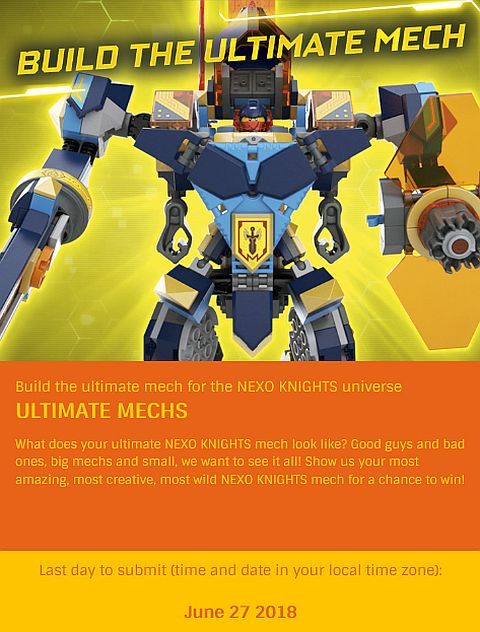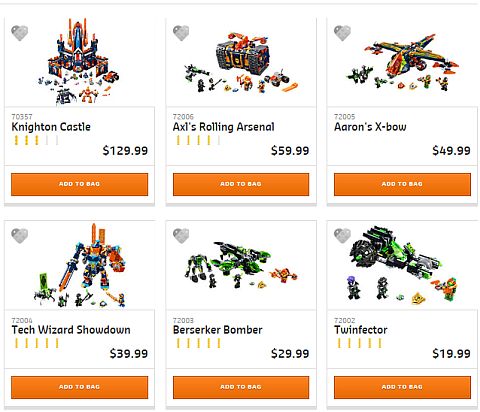LEGO is running an exciting new contest for teen and adult LEGO fans. This time, the challenge is to build the ultimate LEGO Nexo Knights mech. As usual, the contest is interesting and challenging, and the prizes are amazing. You can find details of the contest below. 🙂

➡ LEGO ULTIMATE MECHS CONTEST – OVERVIEW: Mechs, or large mobile suit of armor, are an important part of the LEGO Nexo Knights series. For this challenge, build the ultimate mech for the LEGO Nexo Knights universe! What does your ultimate LEGO Nexo Knights mech look like? Good guys and bad ones, big mechs and small, we want to see it all! Show us your most amazing, most creative, most wild LEGO Nexo Knights mech for a chance to win!
➡ LEGO ULTIMATE MECHS CONTEST – HOW TO ENTER: Create your ultimate LEGO Nexo Knights mech. Take up to five photos of your entry and submit them to the contest. Use the description field to describe your entry – then hit “submit”. When you receive a “Success!” pop-up notification after clicking “submit” on the entry submission page, your entry has successfully been submitted. The moderation team will review it within 1-3 days (excluding weekends and holidays) to make sure it fits all the contest rules.
➡ LEGO ULTIMATE MECHS CONTEST – RULES: Your mech must fit into the LEGO Nexo Knights world. Entries with military themes will not be eligible for the contest. Entries containing defamatory or degrading elements will not be eligible for the contest. Entries not consist of or contain copies of any other existing third party work or creation or infringements of any third party intellectual property right. This means all entries containing third party IPs, such as printed parts or minifigure accessories from Marvel and DC Super Heroes, Star Wars, Lord of the Rings, Harry Potter, etc. will not be eligible for the contest. Entries can be previously built, but cannot be submitted previously in any contest of any kind competing for a prize. Each entry must have been made by the user submitting it, submitting entries you did not make yourself could result in your account being removed and all entries being disqualified. Use of LEGO Digital Designer to create your entry is allowed, along with photo editing software or adding effects to your entry. Entries must not contain LEGO elements which have been modified from their original form, including painted or cut elements. Entrants must be at least 13 years of age at the time of entry. You can read the rest of the entry guidelines and rules here.
➡ LEGO ULTIMATE MECHS CONTEST – DEADLINE: You must submit your entry by June 27th, 2018 at 10:00 AM EST. If you are not sure what time zone you are in, you can use an online time-zone converter to make sure you don’t miss the deadline.
➡ LEGO ULTIMATE MECHS CONTEST – JUDGES: A panel of judges from the LEGO Nexo Knights team will select one grand prize winner and two runner up winners. They will judge entries upon: overall coolness and originality – 25%, most inspired details – 25%, relevance to contest theme – 25%, best use of LEGO elements – 25%.

➡ LEGO ULTIMATE MECHS CONTEST – PRIZES: There will be one grand prize winner, who will receive the following: #72001 LEGO Nexo Knights Lance’s Hover Jouster, #72002 LEGO Nexo Knights Twinfector, #72003 LEGO Nexo Knights Berserker Bomber, #72004 LEGO Nexo Knights Tech Wizard Showdown, #72005 LEGO Nexo Knights Aaron’s X-bow, #72006 LEGO Nexo Knights Axl’s Rolling Arsenal, #70357 LEGO Nexo Knights Knighton Castle, plus a $400 USD shopping spree at the Online LEGO Shop, a LEGO Nexo Knights poster signed by a LEGO designer, and a collection of LEGO Nexo Knights merchandise. There will be two runner up winners, who will receive the same collection of LEGO Nexo Knights sets, plus a $100 USD shopping spree at the Online LEGO Shop.

➡ LEGO MECHS CONTEST – WINNERS ANNOUNCEMENT: Winners will be contacted on the email address associated with their LEGO ID account after July 11th, 2018 and announced on ReBrick when the winners returned the signed Winner’s Certification Documents. A winner who does not return their Winner’s Certification Document within one week (5 days) of receiving it will be disqualified, and a new winner will be selected.
Contests to build LEGO mechs are always super popular, so I expect the LEGO Nexo Knights Ultimate Mechs Contest to be well received by the LEGO fan community with lots of great entries. Please note that you don’t have to own any LEGO Nexo Knights sets to enter the contest, just build your mech in the style of LEGO Nexo Knights, and you are good to go. For inspiration, you can check out the currently available LEGO Nexo Knights sets (including some awesome mechs) at the LEGO Nexo Knights section of the Online LEGO Shop.

What do you think? How do you like this LEGO mechs contest? Are you planning to enter? Have you built any of the LEGO Nexo Knights mechs and other sets? Feel free to share your thoughts and discuss in the comment section below! 😉
And you might also like to check out the following related posts:

















